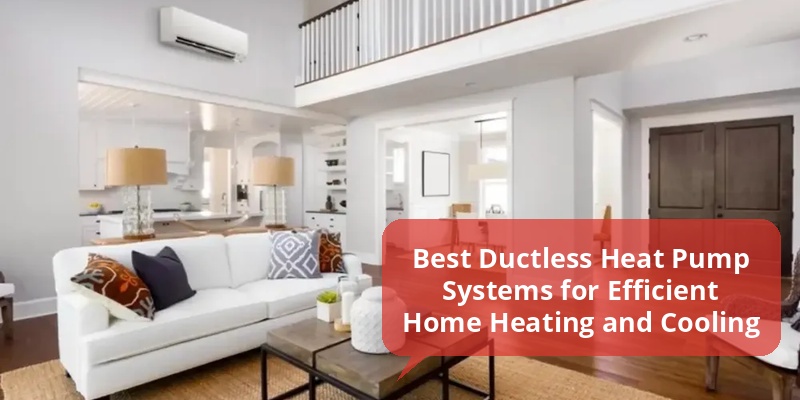Ductless heat pumps offer an energy-efficient solution for heating and cooling residential and commercial spaces without the need for ductwork. Designed for flexibility, they provide targeted temperature control, reducing energy costs and improving comfort. This article explores the best ductless heat pump systems available, comparing features, benefits, and key considerations to help American homeowners and business owners make informed decisions.
| Heat Pump Model | Heating Capacity (BTU) | Cooling Capacity (BTU) | Energy Efficiency Ratio (SEER) | Price Range |
|---|---|---|---|---|
| Mitsubishi M-Series | 9,000 – 36,000 | 9,000 – 36,000 | Up to 30.5 SEER | $1,500 – $4,000 |
| Fujitsu Halcyon | 9,000 – 36,000 | 9,000 – 36,000 | Up to 33.1 SEER | $1,400 – $3,800 |
| LG Multi V S | 9,000 – 48,000 | 9,000 – 48,000 | Up to 26 SEER | $1,600 – $5,000 |
| Daikin LV Series | 9,000 – 24,000 | 9,000 – 24,000 | Up to 23 SEER | $1,300 – $3,500 |
How Ductless Heat Pumps Work
Ductless heat pumps, also known as mini-split systems, transfer heat between indoor and outdoor units using refrigerant cycles. Unlike traditional HVAC systems that use ductwork, these systems install an outdoor compressor connected by refrigerant lines directly to one or multiple indoor air handlers. During cold months, the heat pump extracts heat from outside air and transfers it inside. In warm months, the process reverses to cool indoor air efficiently.
This technology allows for zoned heating and cooling, reducing energy waste by heating or cooling only occupied areas. Additionally, ductless heat pumps improve indoor air quality by filtering air and minimizing the circulation of dust through ducts.
Top Features to Consider in a Ductless Heat Pump
- Heating and Cooling Capacity: Choose a unit sized accurately for the space to maximize efficiency and comfort.
- Energy Efficiency Ratings (SEER and HSPF): Higher Seasonal Energy Efficiency Ratio (SEER) and Heating Seasonal Performance Factor (HSPF) values translate to lower utility bills.
- Multi-Zone Capability: Systems supporting multiple indoor units provide individualized temperature control for different rooms.
- Noise Levels: Quiet operation enhances user experience, especially in bedrooms or offices.
- Installation and Maintenance: Look for certified installers and units designed for easy maintenance.
- Smart Controls and Connectivity: Wi-Fi enabled models offer remote system management, scheduling, and integration with home automation.
Best Ductless Heat Pump Brands and Models
Mitsubishi M-Series
The Mitsubishi M-Series is widely regarded as a leader in ductless heat pump technology. These units offer powerful heating and cooling capabilities with SEER ratings up to 30.5, providing outstanding energy efficiency. Their multi-zone options enable customized comfort solutions. Features include advanced filtration and whisper-quiet operation ideal for bedrooms and living rooms.
Fujitsu Halcyon
Fujitsu’s Halcyon line is known for high-performance ductless systems featuring top-tier SEER ratings of up to 33.1. The units incorporate inverter technology that adjusts compressor speed for energy savings and consistent temperature control. Many models support simultaneous heating and cooling, which is useful in mixed climate zones.
LG Multi V S
LG’s Multi V S series caters to larger homes and commercial spaces, with higher capacity options up to 48,000 BTUs. Their energy-efficient design supports up to 26 SEER. The system offers smart features like app control and integration with voice assistants. Additionally, LG’s focus on eco-friendly refrigerants reduces environmental impact.
Daikin LV Series
Daikin, a pioneer in HVAC innovation, provides reliable and cost-effective ductless heat pumps through its LV Series. These models deliver SEER ratings up to 23 and solid heating performance even in colder climates. Daikin units emphasize durability and ease of installation, supported by strong warranties and service networks nationwide.
Energy Efficiency and Cost Savings with Ductless Heat Pumps
Ductless heat pumps consume significantly less energy than traditional HVAC systems, particularly in moderate climates. By eliminating duct losses, which can account for up to 30% energy waste, these systems optimize heating and cooling efficiency. Energy Star-rated models further reduce electricity consumption, leading to monthly savings.
Incentives and rebates offered by federal, state, and local programs in the U.S. often apply to ductless heat pumps, lowering upfront costs. Over a 10 to 15-year lifespan, homeowners usually recoup installation expenses through decreased energy bills and improved system reliability.
Installation Considerations and Maintenance Tips
Proper installation is critical for maximizing a ductless heat pump’s performance. Installation includes mounting the indoor air handlers, connecting refrigerant lines to the outdoor compressor, and ensuring leak-free seals. Working with a certified HVAC professional guarantees compliance with local regulations and optimal system setup.
Routine maintenance involves:
- Cleaning or replacing air filters every 1 to 3 months to maintain airflow and indoor air quality.
- Checking refrigerant levels and inspecting outdoor coils for debris to ensure efficient operation.
- Scheduling annual professional tune-ups to detect and address potential issues early.
Comparing Ductless Heat Pumps with Traditional HVAC Systems
| Aspect | Ductless Heat Pumps | Traditional HVAC Systems |
|---|---|---|
| Energy Efficiency | Higher efficiency due to no duct losses and inverter technology | Lower efficiency; energy loss through ductwork common |
| Installation | Less invasive; no ductwork required | Requires duct installation or maintenance; more invasive |
| Zoning | Individual room control | Often single-zone or limited zoning options |
| Maintenance | Regular filter cleaning; less duct maintenance | Duct cleaning and maintenance needed |
| Cost | Higher initial unit price; lower operating costs | Variable installation cost; higher energy bills |
Factors Affecting the Selection of the Best Ductless Heat Pump
- Climate Zone: Colder regions benefit from models with stronger heating capabilities and cold climate certifications.
- Space Size and Layout: Larger homes may require multi-zone systems; open floor plans might need strategic indoor unit placement.
- Budget: Balancing initial investment with anticipated energy savings is crucial.
- Rebates and Incentives: Check eligibility for financial incentives to reduce costs.
- Brand Reputation and Warranty: Choose trusted manufacturers offering comprehensive warranties and customer support.
